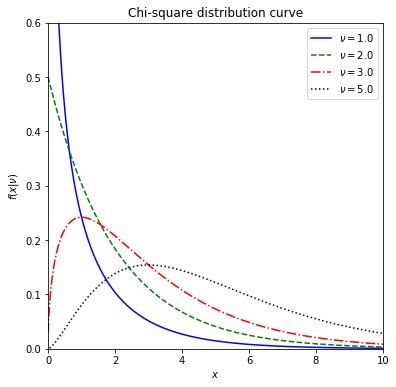Chi-square distribution
Chi-square distribution¶
Let’s investigate how shape of the chisquare distribution curve look likes.
# import required libraries
import numpy as np
import matplotlib.pyplot as plt
import scipy.stats as stats
from IPython.display import display
Let’s now investigate how shape of the chi-square distribution curve changes with respect to degrees of freedom (\(\nu\)). We will define a function first to simplify our calculations.
# define a Python function with three parameters
def chi2_dist_curve(dof, ltype, col):
fig, ax = plt.subplots(figsize = (6, 6))
#use zip for parallel iteration
for d, l, cl in zip(dof, ltype, col):
#generate 10000 random variables for given degrees of freedom
x = stats.chi2.rvs(df = d, size = 10000)
x1 = np.sort(x)
plt.plot(x1, stats.chi2.pdf(x1, df = d),
ls = l, c = cl, label = r'$\nu=%.1f$' % (d))
plt.xlim(0, 10) #change as needed
plt.ylim(0, 0.6) #change as needed
plt.xlabel('$x$')
plt.ylabel(r'$f(x|\nu)$')
plt.title('Chi-square distribution curve')
plt.legend(loc='upper right')
plt.show()
Now play with the function to see the changes on the normal distribution curve.
## change the following values as you wish
## define the input arguments (values of the parameters)
dof_values = [1, 2, 3, 5]
linestyles = ['-', '--', '-.', ':']
colors = ['blue', 'green','red','black']
chi2_curve = chi2_dist_curve(dof = dof_values, ltype = linestyles, col = colors)
display(chi2_curve)

None
Calculate probabilities associated with chi-square distribution with ‘stats.chi2.cdf(x, df)’.
#example in class
# x follows a chi-square with 5 dof
prob_int = stats.chi2.cdf(x = 12.83, df = 5) - stats.chi2.cdf(x = 1.145, df = 5)
print("%.4f"%prob_int)
0.9250
